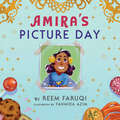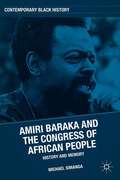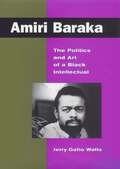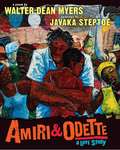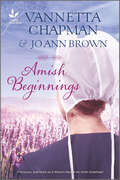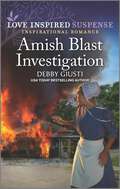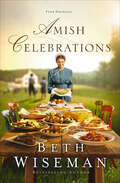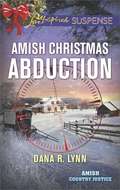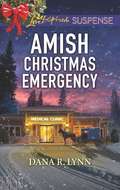- Table View
- List View
Amir and the Jinn Princess
by M. T. KhanIn this mesmerizing novel, a wealthy young boy searching for his mother teams up with a fiery jinn princess all while battling in a tournament of heirs—and trying to keep his life from changing forever. Twelve-year-old Amir is one of the heirs to the Rafiq Bricks Company, a wealthy brick kiln business in Pakistan—except he wants none of it. Seeing straight through the jeweled smiles and transactional conversations, Amir would rather spend time in the courtyard garden, where he can almost feel his missing mother&’s presence again. Amir is devastated when his baba announces plans to remarry by the end of the summer, dropping all searches to find Amir&’s mother. It&’s all a business move, just like everything else in his life. His mother was the only one who allowed him to feel normal, but the last anyone&’s seen of her was a year ago. But Amir isn&’t ready to give up yet—determined to find his mother before his life changes forever, Amir teams up with a high-spirited, wide-eyed, shape-shifting jinn princess named Shamsa. His exact opposite. The two make a deal—Shamsa will help Amir navigate the twisty and mysterious realm of jinn, and in exchange Amir must use his wits to help Shamsa win a tournament of heirs and put her on the throne. Amir and Shamsa must contend with silver-tongued tricksters and magical rivals, and a truth far more devastating than Amir ever expected.…
Amira & Hamza: The Quest for the Ring of Power (Amira & Hamza)
by Samira AhmedAmira and Hamza are back in this epic sequel, which takes readers on a thrilling magical adventure as the siblings face their most terrifying and formidable opponent yet.All human and jinn kind shall bow down to me. Control the Ring, control the worlds. Amira and Hamza have returned from Qaf, the magical Jinn world, as triumphant heroes—and life has been pleasantly quiet. Too quiet. Hamza is determined to have one last monumental, epic adventure before summer ends. But when sneaking off to explore an old, abandoned castle goes from life-changing adventure to potentially deadly, Amira and Hamza find themselves in the middle of another dangerous quest to save the worlds. One they didn&’t bargain for. The siblings are brought face to face with the evil dev, Ahriman, angry and out for revenge. And if Amira and Hamza thought Ifrit was bad, his dad Ahriman, the last in an ancient line of fire spirits, is far worse. Ahriman kidnaps Hamza and forces him to help locate the lost Ring of Power, an ancient and mysterious artifact that will allow him to rule the universe. Desperate to save her brother, Amira must outsmart perilous traps and confounding puzzles in a race against time to retrieve the artifact before Ahriman does... or say goodbye to Hamza and their world forever.
Amira & Hamza: The War to Save the Worlds
by Samira AhmedFrom bestselling author Samira Ahmed comes a thrilling fantasy adventure intertwining Islamic legend and history, perfect for fans of Aru Shah and the Land of Stories. On the day of a rare super blue blood moon eclipse, twelve-year-old Amira and her little brother, Hamza, can&’t stop their bickering while attending a special exhibit on medieval Islamic astronomy. While stargazer Amira is wowed by the amazing gadgets, a bored Hamza wanders off, stumbling across the mesmerizing and forbidden Box of the Moon. Amira can only watch in horror as Hamza grabs the defunct box and it springs to life, setting off a series of events that could shatter their world—literally. Suddenly, day turns to night, everyone around Amira and Hamza falls under a sleep spell, and a chunk of the moon breaks off, hurtling toward them at lightning speed, as they come face-to-face with two otherworldly creatures: jinn. The jinn reveal that the siblings have a role to play in an ancient prophecy. Together, they must journey to the mystical land of Qaf, battle a great evil, and end a civil war to prevent the moon—the stopper between realms—from breaking apart and unleashing terrifying jinn, devs, and ghuls onto earth. Or they might have to say goodbye to their parents and life as they know it, forever.…
Amira's Picture Day
by Reem FaruqiRamadan has come to an end, and Amira can't wait to stay home from school to celebrate Eid. There's just one hiccup: it's also school picture day. How can Amira be in two places at once?Just the thought of Eid makes Amira warm and tingly inside. From wearing new clothes to handing out goody bags at the mosque, Amira can't wait for the festivities to begin. But when a flier on the fridge catches her eye, Amira's stomach goes cold. Not only is it Eid, it's also school picture day. If she's not in her class picture, how will her classmates remember her? Won't her teacher wonder where she is?Though the day's celebrations at the mosque are everything Amira was dreaming of, her absence at picture day weighs on her. A last-minute idea on the car ride home might just provide the solution to everything in this delightful story from acclaimed author Reem Faruqi, illustrated with vibrant color by Fahmida Azim.
Amiri Baraka and Edward Dorn: The Collected Letters (Recencies Series: Research and Recovery in Twentieth-Century American Poetics)
by Claudia Moreno PisanoFrom the end of the 1950s through the middle of the 1960s, Amiri Baraka (b. 1934) and Edward Dorn (1929–99), two self-consciously avant-garde poets, fostered an intense friendship primarily through correspondence. The early 1960s found both poets just beginning to publish and becoming public figures. Bonding around their commitment to new and radical forms of poetry and culture, Dorn and Baraka created an interracial friendship at precisely the moment when the Civil Rights Movement was becoming a powerful force in national politics. The major premise of the Dorn-Jones friendship as developed through their letters was artistic, but the range of subjects in the correspondence shows an incredible intersection between the personal and the public, providing a schematic map of what was so vital in postwar American culture to those living through it.Their letters offer a vivid picture of American lives connecting around poetry during a tumultuous time of change and immense creativity. Reading through these correspondences allows access into personal biographies, and through these biographies, profound moments in American cultural history open themselves to us in a way not easily found in official channels of historical narrative and memory.
Amiri Baraka and the Congress of African People
by Michael SimangaThis important look at CAP combines historical research and analysis with the author's first-hand experience with the organization, providing the first historical narrative of a consequential player in the Black Power Movement.
Amiri Baraka: The Politics and Art of a Black Intellectual
by Jerry WattsAmiri Baraka, formerly known as LeRoi Jones, became known as one of the most militant, anti-white black nationalists of the 1960s Black Power movement. An advocate of Black Cultural Nationalism, Baraka supported the rejection of all things white and western. He helped found and direct the influential Black Arts movement which sought to move black writers away from western aesthetic sensibilities and toward a more complete embrace of the black world. Except perhaps for James Baldwin, no single figure has had more of an impact on black intellectual and artistic life during the last forty years. In this groundbreaking and comprehensive study, the first to interweave Baraka's art and political activities, Jerry Watts takes us from his early immersion in the New York scene through the most dynamic period in the life and work of this controversial figure. Watts situates Baraka within the various worlds through which he travelled including Beat Bohemia, Marxist-Leninism, and Black Nationalism. In the process, he convincingly demonstrates how the 25 years between Baraka's emergence in 1960 and his continued influence in the mid-1980s can also be read as a general commentary on the condition of black intellectuals during the same time. Continually using Baraka as the focal point for a broader analysis, Watts illustrates the link between Baraka's life and the lives of other black writers trying to realize their artistic ambitions, and contrasts him with other key political intellectuals of the time. In a chapter sure to prove controversial, Watts links Baraka's famous misogyny to an attempt to bury his own homosexual past. A work of extraordinary breadth, Amira Baraka is a powerful portrait of one man's lifework and the pivotal time it represents in African-American history. Informed by a wealth of original research, it fills a crucial gap in the lively literature on black thought and history and will continue to be a touchstone work for some time to come.
Amiri and Odette
by Walter Dean MyersPresents a modern, urban retelling in verse of the ballet in which brave Amiri falls in love with beautiful Odette and fights evil Big Red for her on the streets of the Swan Lake Projects.
Amirs, Admirals & Desert Sailors
by David F. WinklerHost to the U.S. Navy for nearly six decades, Bahrain has been a steadfast American ally in the turbulent Middle East. Its unique relationship with the United States evolved through a series of friendships between Bahrain s ruling Al Khalifa royal family and top U.S. Navy flag officers assigned to the fleet in the Gulf. Over the years it has become a strategic partnership critical to global security.As naval historian David F. Winkler examines these developing relationships, he offers a fascinating overview of Bahraini history, the entry of American humanitarian and economic interests, the establishment of an American naval presence in the Cold War, the Arab-Israeli conflicts, and the downfall of the Iranian shah, among other subjects. The author tells the story from both Bahraini and American perspectives.Given U.S. commitment to the region and its concurrent objectives of combating the global war on terrorism and establishing democracy, this book provides an important historical context for those interested in a crucial facet of American foreign relations. While many works describe the history of U.S. diplomatic and military involvement in the Gulf, this is the first to cover in depth the history of the U.S. Navy in Bahrain.
Amish Baby Lessons
by Patrice LewisA brokenhearted Amish woman teaches a bachelor how to care for his niece in this inspirational romance.Tall, plain and awkward, Amish maed Jane Troyer has always been “useful.” Now she’s the temporary nanny for overwhelmed Amish bachelor Levy Struder and his baby niece. But Jane’s finding it hard to resist falling for the sweet boppli and the handsome, hardworking Levy. Can this spirited Plain Jane win a bachelor’s heart . . . and make their temporary arrangement permanent?From Harlequin Love Inspired: Uplifting stories of faith, forgiveness and hope.
Amish Baking: Traditional Recipes for Bread, Cookies, Cakes, and Pies
by Good Books100 authentic Amish yeast breads, quick breads, cakes, cookies, bars, pies, and more! Gathered from interviews with real Amish grandmothers, tattered recipe boxes, and old books and diaries, here is an assortment of delicious baked goods that have been and continue to be popular in eastern Pennsylvania, particularly in the Lancaster area. Now you too can experience the warm, comforting recipes of old order Amish cooks. Prepare to make wonderful treats such as: Potato BunsGlazed DoughnutsSchnitz PieShoofly PieHot Milk Sponge CakeMolasses CookiesOatmeal Whoopie PiesWhole Wheat BreadCorn BreadAnd more! These recipes will soon become your family favorites and go-to desserts for bake sales or potluck dinners. With simple ingredients and instructions that are easy to follow, you'll find yourself whipping up the same wonderful baked goods you can find in Amish markets or farm stands.
Amish Beginnings
by Jo Ann Brown Vannetta ChapmanTwo Amish stories of faith and healingA Widow’s Hope by Vannetta ChapmanAfter tragedy claimed her husband’s life and her son’s ability to walk, Hannah King doesn’t want a new man. She has her family, a home and mounting debts. Scarred Amish bachelor Jacob Schrock offers Hannah the job she desperately needs. But while Hannah helps Jacob resolve his accounting issues, can she and her little boy also heal his wounded heart?His Amish Sweetheart by Jo Ann BrownNathaniel Zook returns to his Amish community after inheriting his grandparents’ alpaca farm. His childhood best friend, schoolteacher Esther Stoltzfus, is the one person who can help him save the homestead. Soon, caring for the sweet alpacas—and a young orphaned boy—is bringing Nathaniel and Esther closer than ever. Yet Nathaniel will have to risk sharing all that’s in his heart to form the family he always dreamed of.
Amish Blast Investigation
by Debby GiustiA deadly explosion. A dangerous search for the truth.After an explosion rocks Becca Klein&’s bakery and kills one of her customers, she teams up with the victim&’s son to find justice. Though estranged from his father, Englischer Luke Snyder is compelled to help the Amish woman uncover why his father died. But ruthless killers believe Luke&’s father gave Becca something they want, and they&’ll stop at nothing to get it. Can Luke keep Becca safe until they discover the truth?From Love Inspired Suspense: Courage. Danger. Faith.
Amish Brides
by Jennifer Beckstrand Amy Lillard Molly JebberUnder bright blue skies, wedding bells ring—fulfilling sweet dreams, impossible wishes, and joyous new beginnings . . .THE RELUCTANT GROOM Jennifer Beckstrand Spirited Suvie Newswenger has three marriage proposals—but not from the man she truly loves. No matter how lonely widower Aaron Beachy is, he seems determined to stay that way forever. Now, with help from his matchmaking great-grandparents, Suvie will do whatever it takes to rekindle Aaron’s hope—and spark happiness for a lifetime.JOSHUA’S BRIDE Molly Jebber Madeline Lehman fears her fiancé’s family will never accept her because of her rebellious sister. She’s postponed her wedding to Joshua Stutzman until they see the truth. But when Maddie adopts her sister’s abandoned baby, can she and Joshua find a way to unite their families through forgiveness as well as love?A SUMMER WEDDING IN PARADISE Amy LillardReba Schmucker longs to be a bride. And she knows her mischievous nieces just wanted to help when they “chose” Abel Weaver for her. But he’s the last man in the world she’d ever marry. There’s no way her independence and his stubbornness could ever get along—unless a sudden crisis somehow leads to understanding . . . and love.
Amish Brides
by Jennifer Beckstrand Amy Lillard Molly JebberUnder bright blue skies, wedding bells ring—fulfilling sweet dreams, impossible wishes, and joyous new beginnings . . . THE RELUCTANT GROOM Jennifer Beckstrand Spirited Suvie Newswenger has three marriage proposals—but not from the man she truly loves. No matter how lonely widower Aaron Beachy is, he seems determined to stay that way forever. Now, with help from his matchmaking great-grandparents, Suvie will do whatever it takes to rekindle Aaron’s hope—and spark happiness for a lifetime. JOSHUA’S BRIDE Molly Jebber Madeline Lehman fears her fiancé’s family will never accept her because of her rebellious sister. She’s postponed her wedding to Joshua Stutzman until they see the truth. But when Maddie adopts her sister’s abandoned baby, can she and Joshua find a way to unite their families through forgiveness as well as love? A SUMMER WEDDING IN PARADISE Amy Lillard Reba Schmucker longs to be a bride. And she knows her mischievous nieces just wanted to help when they “chose” Abel Weaver for her. But he’s the last man in the world she’d ever marry. There’s no way her independence and his stubbornness could ever get along—unless a sudden crisis somehow leads to understanding . . . and love.
Amish Butters, Salsas & Spreads: Making and Canning Sweet and Savory Jams, Preserves, Conserves, and More
by Laura Anne Lapp60 traditional Amish recipes for apple butter, cranberry chutney, corn salsa, and more!The Amish are known for their canning practices, which are essential to communities of large families and even larger gardens. Written by Amish writer Laura Anne Lapp, Amish Butters & Salsas offers sixty classic recipes for all varieties of spreads, fruit butters, sweet and savory chutneys, salsas, and more.Recipes are written with Amish-style simplicity and no-nonsense instructions, perfect for novices and experienced preservationists alike. Recipes include a multitude of preserves that are perfect for storing in your own pantry or gifting to friends and family. Find recipes such as:Peach-ginger butterPumpkin spice butterTomato basil salsaAmish wedding salsaAmish church spreadAmish peanut butter spreadCheese spreadAnd much more!Amish Butters & Salsas gives readers a close-up of a world seldom seen to show how canning and preserving and Amish life work rhythmically together.&“Growing up Amish, the eldest daughter in a family of seven, canning and preserving were always a part of family life, a part of summertime that went hand in hand with gardening. Now, as a mother of four growing boys with a large garden, I still find canning and preserving a part of my summer tradition. I love gardening, and preserving the beauty of my garden is just another part of that tradition.&”
Amish Candy Shop Holidays Bundle (An Amish Candy Shop Mystery)
by Amanda FlowerCRIMINALLY COCOA As if being in New York City for Easter isn&’t exciting enough, Charlotte Weaver is helping her cousin, Bailey, on the set of her first cable TV show, Bailey&’s Amish Sweets. Charlotte notices odd events intended to make Bailey look bad . . . and realizes her cousin has a dangerously jealous rival. Can she find out who—before someone&’s sour grapes turn fatally bitter? BOTCHED BUTTERSCOTCH Mother&’s Day is a sweet and busy time at the candy shop Bailey King runs with her Amish grandmother. This year, Bailey&’s parents are visiting, and for Mother&’s Day Tea at the local church, Bailey&’s whipping up her mom&’s favorite: butterscotch fudge. All&’s going well, until a sticky-fingered thief makes off with the money raised for a local women&’s support group. Can Bailey find the culprit before events boil over into disaster? CANDY CANE CRIME Thanks to her new cable TV show, Bailey&’s shop has more orders than she can handle this Christmas. Fortunately, her beloved Cousin Charlotte is organizing the Candy Cane Exchange, pairing sweet notes with a peppermint treat. Charlotte is delighted to discover she may have a secret admirer…until she sees something underhanded going on beneath the merrymaking. Can she stop a local Grinch before the holiday, and her fledgling romance, are ruined? Recipes Included! Praise for Amanda Flower and her Amish cozies &“As it turns out, Amanda Flower may have just written the first Amish rom com.&”—USA Today &“Flower has hit it out of the ballpark . . . and continues to amaze with her knowledge of the Amish way of life.&”—RT Book Reviews &“At turns playful and engaging . . . a satisfyingly complex cozy.&”—Library Journal
Amish Canning & Preserving: How to Make Soups, Sauces, Pickles, Relishes, and More
by Laura Anne LappEnter the Amish world of hard work, sturdy families, and the freshest produce. The Amish are known for their canning practices, which are essential to communities of large families and even larger gardens. Written by Amish writer Laura Anne Lapp, Amish Canning & Preserving offers sixty classic recipes for all varieties of fresh garden-made fruits and vegetables. Recipes are written with Amish-style simplicity and no-nonsense instructions, perfect for novices and experienced preservationists alike. Recipes include a multitude of homemade pickles, relishes, brines, and more!Amish Canning & Preserving gives readers a close-up of a world seldom seen to show how canning and preserving and Amish life work rhythmically together.
Amish Celebrations: Four Novellas
by Beth WisemanFrom bestselling author Beth Wiseman come four sweet stories centered around celebrations in the Amish community: rumschpringe, baptism, weddings, and Christmas.The Gift of SistersHannah and Rachel are fraternal twins approaching their sixteenth birthday—a time when they will be allowed to spread their wings and enjoy their rumschpringe. The sisters couldn&’t be more different: Hannah is outgoing and beautiful, while Rachel is shy and withdrawn. And when newcomer Abraham Stoltzfus arrives in Lancaster County, both women fall head over heels for him, each fighting for his affections in their own ways and driving the sisters to turn on each other. Who will Abraham choose? And will Hannah and Rachel reunite after a devastating heartbreak?A New BeginningRebecca and Noah are in love and about to be baptized. But when Noah decides to enjoy one last night of his rumschpringe a few weeks before the ceremony, he does something that causes Rebecca to reconsider his proposal. As Rebecca and Noah navigate the turn in their relationship, Rebecca must learn to forgive Noah or abandon her dreams of marrying him. If Noah won&’t forgive himself in time for the baptism, his guilt could cause him to run from his love for Rebecca and leave his community behind.A Perfect Plan (previously published in An Amish Wedding)Priscilla King has been planning to marry Chester Lapp since she was sixteen years old, and when Chester pops the question on Priscilla&’s nineteenth birthday, wedding plans begin immediately. But everything begins to fall apart as Chester works to build a house for his new bride, only to have one disaster after another occur. Can true love take this couple through the challenges that threaten their union, or will they begin to doubt that they are on the right path, the one God has chosen for them?A Christmas MiracleMary is twenty-seven years old and already has five young children. Married to her husband at age eighteen, she wasn&’t quite prepared for motherhood, and exhaustion and frustration are sending her into a downhill spiral as the holidays approach. Too proud and ashamed to ask for help, Mary&’s situation begins to take a toll on her marriage. But when an elderly man in a red suit and his sidekick elf befriend Mary, showering her with wisdom and advice, she must choose to accept help, learn to cope with her situation, and ultimately find the true meaning of Christmas.Sweet, inspirational Amish novellasCollection includes four stories (23K words each) that can be read together or on their ownIncludes discussion questions for book clubs
Amish Christmas Abduction
by Dana R. LynnKIDNAPPED IN AMISH COUNTRY After catching a glimpse of something she wasn’t supposed to see days before Christmas, Irene Martello is run off the road and barely survives. More shocking is the backseat whimper of an Amish toddler stowaway and the familiar sight of their rescuer—the man who’d let her down years earlier. Police chief Paul Kennedy fears Irene stumbled onto a kidnapping ring with two dangerous agendas: retrieving the girl and silencing the witness for good. Only Paul can keep them safe for the holidays. Guarding Irene means risking his heart—and his secret—but to save the child and the woman he never stopped loving, it’s a risk he has to take.
Amish Christmas Blessings and Her Amish Christmas Sweetheart: The Midwife's Christmas Surprise A Christmas To Remember Her Amish Christmas Blessing
by Marta Perry Rebecca Kertz Jo Ann BrownIt’s the holiday season in Amish country—featuring two novellas about couples who find love and family in time for Christmas.Amish Christmas Blessings by Marta Perry and Jo Ann Brown‘Tis the season for two sweet tales of Christmas among the Amish. Can a newborn baby reunite a midwife and her old love in time for the holidays? Will a woman with no memory find refuge on Christmas? These warm and wonderful Amish stories will fill you with the splendor of the season.Her Amish Christmas Sweetheart by Rebecca KertzPeter Zook should be thrilled to spend Christmas planning a party with Meg Stoltzfus. But she’s being courted by another man. In the past, Peter never noticed Meg. So she’s moved on. Yet, as they argue over party details, Meg and Peter’s bond deepens. Will they fall in love this Christmas?
Amish Christmas Blessings: The Midwife's Christmas Surprise A Christmas To Remember
by Marta Perry Jo Ann BrownHoliday Greetings From Amish Country The Midwife's Christmas Surprise by Marta Perry Three years ago, the man Anna Zook hoped to marry left her and their Amish community for the English world. Now devoted to proving her abilities as a midwife, Anna has given up on marriage and children for herself. But when Benjamin Miller returns, now a changed man, can delivering a Christmas baby reunite these two hurting hearts? A Christmas to Remember by Jo Ann Brown When a little girl leads shop owner Amos Stoltzfus to an Amish woman in distress, he rushes them to his family's farm. "Linda" has no memory and doesn't know if the sweet child is her daughter or even her kin. As Christmas arrives and Linda's identity is revealed, will Amos be able to claim his holiday guests as his own?
Amish Christmas Cookbook: Authentic Favorites from Three Generations of Amish Cooks
by Linda Byler Laura Anne Lapp Anna Kauffman100 authentic Amish Christmas treats to share with loved ones this holiday season. Gathered from interviews with real Amish grandmothers, tattered recipe boxes, and old books and diaries, here is an assortment of delicious baked goods, casseroles, snacks, and other festive treats that have been and continue to be popular in eastern Pennsylvania, particularly in the Lancaster area. Christmas is a special time in Amish country—candles in the windows, preparations for the school Christmas play, and gas-powered ovens filling homes with the smells of home-baked goodness. Now you too can experience the warm, comforting recipes of old order Amish cooks. Prepare to make wonderful treats such as: Shoofly PieMolasses CookiesFrosted Cinnamon RollsChurch Peanut Butter Marshmallow SpreadBreakfast CasseroleBaked French ToastRed Beet EggsChristmas SaladChristmas Cake"Roasht" or Chicken FillingPotpie NoodlesOatmeal Whoopie PiesAnd more! With simple ingredients and instructions that are easy to follow, you'll find yourself whipping up new mealtime traditions for your loved ones this holiday season.
Amish Christmas Emergency: Amish Christmas Emergency Christmas Hideout Christmas Under Fire (Amish Country Justice #5)
by Dana R. LynnThere’s nowhere to hide from a deadly stalker…Can Amish Country Justice save her?The peaceful Amish community seems like the perfect refuge for nurse Alexa Grant—until her stalker returns. And when menacing gifts and threats turn into attempts on her life, she knows she’ll never be safe without the help of police officer Gavin Jackson. Yet Gavin’s growing closeness to Alexa enrages the stalker, who is determined to cancel Christmas for them…permanently.
Amish Christmas Escape (Amish Country Justice #12)
by Dana R. LynnFrom USA TODAY Bestselling Author Dana R. Lynn Hiding in Amish country may not be enough to save her… In a killer&’s sights after she witnesses her sister&’s murder, Christy O&’Malley&’s only option is to flee to Amish country—and the estranged husband she left behind. But there&’s something Sam Burkholder doesn&’t know—they have a daughter. With enemies closing in, Sam will do anything to protect Christy and their little girl…but can he forgive the past for a chance to be a family for Christmas?From Love Inspired Suspense: Courage. Danger. Faith.Amish Country Justice Book 1: Plain TargetBook 2: Plain RetributionBook 3: Amish Christmas AbductionBook 4: Amish Country AmbushBook 5: Amish Christmas EmergencyBook 6: Guarding the Amish MidwifeBook 7: Hidden in Amish CountryBook 8: Plain RefugeBook 9: Deadly Amish ReunionBook 10: Amish Country ThreatsBook 11: Covert Amish InvestigationBook 12: Amish Christmas Escape



